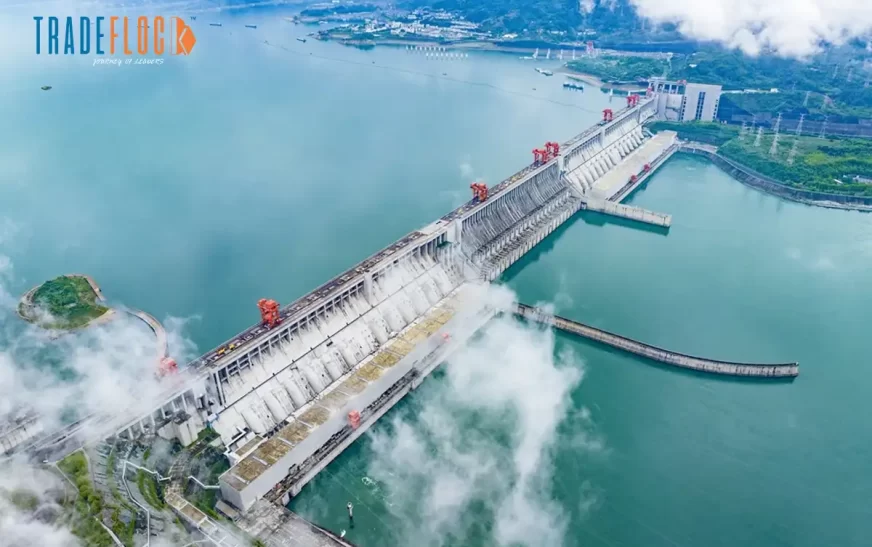On 19 July 2025, Chinese Premier Li Qiang officially broke ground on a project that may soon become the largest hydropower dam in the world. Located in the lower reaches of the Yarlung Zangbo River, known downstream as the Brahmaputra, the development comprises five cascade hydropower stations on a river stretch where it plunges 2,000 metres across 50 km. Once complete, it is expected to generate approximately 300 billion kilowatt‑hours annually, three times the output of the Three Gorges Dam.
This dam, estimated at 1.2 trillion yuan (around US $170 billion), marks the centrepiece of China’s energy ambition and its transition towards carbon neutrality by 2060.
Why This Project, Why Now?
Approved in December 2024, construction began in mid‑2025 under the aegis of China Yajiang Group, a new state-owned enterprise formed for the purpose. Part of the wider 14th Five-Year Plan, this mega‑project follows in the footsteps of Three Gorges and Baihetan dams. It is intended to deliver enormous long-term power capacity, support clean energy goals, and stimulate regional economies, especially in remote Tibet.
The dam will transmit most generated electricity to China’s eastern provinces while also meeting local demand within Tibet, generating economic activity across sectors such as construction, tunnelling, and heavy machinery, markets which have already seen stock prices surge in response to the news.
Impact on China’s Energy Landscape
Generating over 300 billion kWh annually, that is more energy than Britain’s entire consumption last year, this project will dramatically enhance China’s renewable energy grid. It is anticipated to bring clean power to millions and reduce reliance on coal in meeting rising demand.
Beyond energy output, the dam represents catch-up in infrastructure-driven economic stimulus. Historically, mega‑dams like Three Gorges created nearly a million jobs, but also displaced over 1.3 million people. Although displacement estimates for this new project are not yet disclosed, NGOs and analysts warn of similar large-scale social disruption.
Geological Risks and Engineering Challenges
The geography of the Yarlung Zangbo Grand Canyon, one of the deepest canyons on Earth, offers immense hydropower potential, but also substantial engineering risks. The steep gorge and complex terrain require construction of long tunnels through Namcha Barwa mountain, combined with excavation deep in a seismically active zone where Himalayan tectonic plates collide.
Chinese geological experts have cautioned that the project may exacerbate risks of earthquake-induced landslides and mud‑rock flows, especially given the region’s narrow and unstable slopes.
Concerns of Downstream Nations
Downstream, the Brahmaputra River flows into India’s Arunachal Pradesh and Assam, then into Bangladesh, serving as a lifeline to hundreds of millions in these countries. Indian authorities have voiced alarm, with the Chief Minister of Arunachal Pradesh warning that the dam could reduce up to 80% of river flow in some regions or in flood situations deliberately release water impacting agriculture and communities.
Officials speak of the dam as a potential “ticking water bomb”, especially in moments of geopolitical tension where water flow might be manipulated as leverage. Similar concerns have been raised in Bangladesh, where even small deviations in seasonal flows are linked to desertification, crop loss, and fishery declines.
Will China Share the Waters Responsibly?
China has officially declared that the project underwent “rigorous scientific evaluation” and would not harm the ecological environment or downstream water rights, asserting it would not disadvantage its neighbours. It has also pledged to maintain communication channels with India and Bangladesh through existing hydrological data-sharing frameworks. However critics respond that no binding water-sharing treaty exists for the Brahmaputra, making assurances difficult to enforce.
Ambition vs. Risk
From China’s perspective, the dam is a “project of the century”, designed to bring clean energy, economic stimulus, infrastructure growth, and alignment with long‑term climate goals. For investors, the announcement triggered rallies in infrastructure and materials stocks, seen as offering stable, long-lived returns in an uncertain economic period.
Yet amid technological ambition, environmental and geopolitical tensions run high. The region’s biodiversity, described as among the richest on Earth, is under threat. Displacement of local Tibetan communities, damage to fragile ecosystems, and risk of seismic disruption remain deeply worrisome to rights and environmental groups. Unless multilateral frameworks and safeguards are put in place, the dam could become a flashpoint of conflict instead of cooperation.
China’s hydropower megadam on the Yarlung Zangbo River may redefine the global scale of renewable energy ambition, from boosting generation capacity to enable economic transformation in Tibet. Yet it also underscores a delicate balancing act between engineering prowess and ecological caution, between sovereign development and shared river governance. The coming years will test whether the “project of the century” becomes a model of transformative infrastructure or a source of regional strain.
Installed Capacity: Approximately 60,000 MW (60 GW) across five cascade power stations
Annual Generation: 300 billion kWh, over three times the capacity of the Three Gorges Dam
Estimated Cost : ¥1.2 trillion (RMB), or approximately US $168 billion
Construction Start Date: Officially commenced on 19 July 2025, flagged as the “project of the century”
Expected Commercial Operation: Mid- to late-2030s (around 2033 planned)
Location: Lower Yarlung Tsangpo, Mêdog (Tibet)











